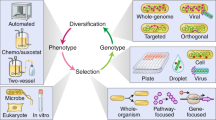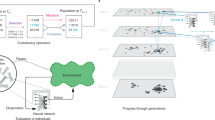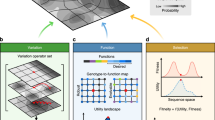Abstract
In recent years, biologists have increasingly been asking whether the ability to evolve — the evolvability — of biological systems, itself evolves, and whether this phenomenon is the result of natural selection or a by-product of other evolutionary processes. The concept of evolvability, and the increasing theoretical and empirical literature that refers to it, may constitute one of several pillars on which an extended evolutionary synthesis will take shape during the next few years, although much work remains to be done on how evolvability comes about.
This is a preview of subscription content, access via your institution
Access options
Subscribe to this journal
Receive 12 print issues and online access
$209.00 per year
only $17.42 per issue
Buy this article
- Purchase on SpringerLink
- Instant access to full article PDF
Prices may be subject to local taxes which are calculated during checkout
Similar content being viewed by others
References
Mayr, E. & Provine, W. B. The Evolutionary Synthesis. Perspectives On The Unification of Biology (Harvard Univ. Press, Cambridge, 1980).
Darwin, C. The Origin Of Species By Means Of Natural Selection: Or, The Preservation Of Favored Races In The Struggle For Life (A. L. Burt (1910), New York, 1859).
Rollo, C. D. Phenotypes: Their Epigenetics, Ecology and Evolution (Chapman & Hall, New York, 1995).
Schlichting, C. D. & Pigliucci, M. Phenotypic Evolution, a Reaction Norm Perspective (Sinauer, Sunderland, 1998).
Carroll, R. L. Towards a new evolutionary synthesis. Trends Ecol. Evol. 15, 27–32 (2000).
Johnson, N. A. & Porter, A. H. Toward a new synthesis: population genetics and evolutionary developmental biology. Genetica 112–113, 45–58 (2001).
West-Eberhard, M. J. Developmental Plasticity and Evolution (Oxford Univ. Press, Oxford, 2003).
Wilkins, A. S. The Evolution of Developmental Pathways (Sinauer, Sunderland, 2002).
Love, A. C. Evolutionary morphology, innovation, and the synthesis of evolutionary and developmental biology. Biol. Philos. 18, 309–345 (2003).
Robert, J. S. Embryology, Epigenesis, and Evolution: Taking Development Seriously (Cambridge Univ. Press, Cambridge, 2004).
Muller, G. B. & Newman, S. A. The innovation triad: an EvoDevo agenda. J. Exp. Zool. B Mol. Dev. Evol. 304, 487–503 (2005).
Brakefield, P. M. Evo–devo and constraints on selection. Trends Ecol. Evol. 21, 362–368 (2006).
Breuker, C. J., Debat, V. & Klingenberg, C. P. Functional evo–devo. Trends Ecol. Evol. 21, 488–492 (2006).
Rieppel, O. Turtles as hopeful monsters. BioEssays 23, 987–991 (2001).
Wagner, G. P., Amemiya, C. & Ruddle, F. Hox cluster duplications and the opportunity for evolutionary novelties. Proc. Natl Acad. Sci. USA 100, 14603–14606 (2003).
Minelli, A. & Fusco, G. Conserved versus innovative features in animal body organization. J. Exp. Zool. B Mol. Dev. Evol. 304, 520–525 (2005).
Alberch, P. From genes to phenotype: dynamical systems and evolvability. Genetica 84, 5–11 (1991).
Dawkins, R. in Artificial Life, The Proceedings Of An Interdisciplinary Workshop On The Synthesis And Simulation Of Living Systems (ed. Langton, C.) 201–220 (Addison-Wesley, Redwood City, 1989).
Schlichting, C. D. & Murren, C. J. in Plant Adaptation: Molecular Genetics and Ecology (eds Cronk, Q. C. B., Whitton, J., Ree, R. H. & Taylor, I. E. P.) 18–29 (NRC Research, Ottawa, 2004).
Fisher, R. A. The Genetical Theory Of Natural Selection (Clarendon, Oxford, 1930).
Flatt, T. The evolutionary genetics of canalization. Q. Rev. Biol. 80, 287–316 (2005).
Griswold, C. K. Pleiotropic mutation, modularity and evolvability. Evol. Dev. 8, 81–93 (2006).
Houle, D. Comparing evolvability and variability of quantitative traits. Genetics 130, 195–204 (1992).
Roff, D. A. The evolution of the G. matrix: selection or drift? Heredity 84, 135–142 (2000).
Jones, A. G., Arnold, S. J. & Burger, R. The mutation matrix and the evolution of evolvability. Evolution 61, 727–745 (2007).
Pigliucci, M. & Kaplan, J. Making Sense of Evolution: Toward a Coherent Picture of Evolutionary Theory (Chicago Univ. Press, Chicago, 2006).
Quayle, A. P. & Bullock, S. Modelling the evolution of genetic regulatory networks. J. Theor. Biol. 238, 737–753 (2006).
Wagner, G. P. & Altenberg, L. Complex adaptations and the evolution of evolvability. Evolution 50, 967–976 (1996).
Camara, M. & Pigliucci, M. Mutational contributions to genetic variance/covariance matrices: an experimental approach using induced mutations in Arabidopsis thaliana. Evolution 53, 1692–1703 (1999).
West-Eberhard, M. J. Evolution in the light of developmental and cell biology, and vice versa. Proc. Natl Acad. Sci. USA 95, 8417–8419 (1998).
Dichtel-Danjoy, M.-L. & Felix, M.-A. Phenotypic neighborhood and micro-evolvability. Trends Genet. 20, 268–276 (2004).
Hansen, T. F. The evolution of genetic architecture. Annu. Rev. Ecol. Syst. 37, 123–157 (2006).
Brookfield, J. F. Y. The evolvability enigma. Curr. Biol. 11, R106–R108 (2001).
Maynard-Smith, J. & Szathmary, E. The Major Transitions in Evolution (Oxford Univ. Press, Oxford, 1995).
Lozada-Chavez, I., Janga, S. C. & Collado-Vides, J. Bacterial regulatory networks are extremely flexible in evolution. Nucleic Acids Res. 34, 3434–3445 (2006).
Tanay, A., Regev, A. & Shamir, R. Conservation and evolvability in regulatory networks: the evolution of ribosomal regulation in yeast. Proc. Natl Acad. Sci. USA 102, 7203–7208 (2005).
Ciliberti, S., Martin, O. C. & Wagner, A. Robustness can evolve gradually in complex regulatory gene networks with varying topology. PLoS Comput. Biol. 3, e15 (2007).
Bergman, A. & Siegal, M. L. Evolutionary capacitance as a general feature of complex gene networks. Nature 424, 549–552 (2003).
Gould, S. J. The evolutionary biology of constraint. Daedalus 109, 39–52 (1980).
Maynard-Smith, J. et al. Developmental constraints and evolution. Q. Rev. Biol. 60, 265–287 (1985).
Wagner, A. Robustness and Evolvability in Living Systems (Princeton Univ. Press, Princeton, 2005).
Hey, J. The neutralist, the fly and the selectionist. Trends Ecol. Evol. 14, 35–37 (1999).
Montville, R., Froissart, R., Remold, S. K., Tenaillon, O. & Turner, P. E. Evolution of mutational robustness in an RNA virus. PLoS Biol. 3, e381 (2005).
Ancel Meyers, L., Ancel, F. D. & Lachmann, M. Evolution of genetic potential. PLoS Comput. Biol. 1, e32 (2005).
de Visser, J. A. G. M. et al. Evolution and detection of genetic robustess. Evolution 57, 1959–1972 (2003).
Landry, C. R., Lemos, B., Rifkin, S. A., Dickinson, W. J. & Hartl, D. L. Genetic properties influencing the evolvability of gene expression. Science 316, 1126 (2007).
Adami, C. Digital genetics: unravelling the genetic basis of evolution. Nature Genet. 7, 109–118 (2006).
Eigen, M. Self-organization of matter and evolution of biological macromolecules. Naturwissenschaften 58, 465 (1971).
Bloom, J. D., Labthavikul, S. T., Otey, C. R. & Arnold, F. H. Protein stability promotes evolvability. Proc. Natl Acad. Sci. USA 103, 5869–5874 (2006).
Hansen, T. F. Is modularity necessary for evolvability? Remarks on the relationship between pleiotropy and evolvability. Biosystems 69, 83–94 (2003).
Carter, A. J. R., Hermisson, J. & Hansen, T. F. The role of epistatic gene interactions in the response to selection and the evolution of evolvability. Theor. Popul. Biol. 68, 179–196 (2005).
Budd, G. E. On the origin and evolution of major morphological characters. Biol. Rev. 81, 609–628 (2006).
Misevic, D., Ofria, C. & Lenski, R. E. Sexual reproduction reshapes the genetic architecture of digital organisms. Proc. R. Soc. B Biol. Sci. 273, 457–464 (2006).
de Visser, J. A. G. M. & Elena, S. F. The evolution of sex: empirical insights into the role of epistasis and drift. Nature Rev. Genet. 8, 139–149 (2007).
Hendrikse, J. L., Parsons, T. E. & Hallgrimsson, B. Evolvability as the proper focus of evolutionary developmental biology. Evol. Dev. 9, 393–401 (2007).
Conrad, M. The geometry of evolution. Biosystems 24, 61–81 (1990).
Gavrilets, S. A dynamical theory of speciation on holey adaptive landscapes. Am. Nat. 154, 1–22 (1999).
Kirschner, M. & Gerhart, J. Evolvability. Proc. Natl Acad. Sci. USA 95, 8420–8427 (1998).
Harrison, F. & Buckling, A. High relatedness selects against hypermutability in bacterial metapopulations. Proc. R. Soc. B Biol. Sci. 274, 1341–1347 (2007).
Schoustra, S. E., Debets, A. J. M., Slakhorst, M. & Hoekstra, R. F. Mitotic recombination accelerates adaptation in the fungus Aspergillus nidulans. PLoS Genet. 3, e68 (2007).
Nijhout, H. F. & Emlen, D. J. Competition among body parts in the development and evolution of insect morphology. Proc. Natl Acad. Sci. USA 95, 3685–3689 (1998).
Earl, D. J. & Deem, M. W. Evolvability is a selectable trait. Proc. Natl Acad. Sci. USA 101, 11531–11536 (2004).
Gould, S. J. & Lewontin, R. C. The spandrels of San Marco and the Panglossian paradigm: a critique of the adaptationist programme. Proc. R. Soc. London B Biol. Sci. 205, 581–598 (1979).
Pigliucci, M. & Kaplan, J. The fall and rise of Dr. Pangloss: adaptationism and the Spandrels paper 20 years later. Trends Ecol. Evol. 15, 66–70 (2000).
Williams, G. C. Adaptation and Natural Selection: a Critique of Some Current Evolutionary Thought (Princeton Univ. Press, Princeton, 1966).
Ariew, A., Cummings, R. & Perlman, M. (eds) Functions: New Essays in the Philosophy of Psychology and Biology (Oxford Univ. Press, New York, 2002).
Mayr, E. The idea of teleology. J. Hist. Ideas 53, 117–135 (1992).
Sniegowski, P. D., Gerrish, P. J., Johnson, T. & Shaver, A. The evolution of mutation rates: separating causes from consequences. Bioessays 22, 1057–1066 (2000).
Bell, G. The evolution of evolution. Heredity 94, 1–2 (2005).
Sniegowski, P. D., Gerrish, P. J. & Lenski, R. E. Evolution of high mutation rates in experimental populations of E. coli. Nature 387, 703–705 (1997).
Wagner, G. P. & Burger, R. On the evolution of dominance modifiers. 2. A nonequilibrium approach to the evolution of genetic systems. J. Theor. Biol. 113, 475–500 (1985).
Rutherford, S. L. & Lindquist, S. Hsp90 as a capacitor for morphological evolution. Nature 396, 336–342 (1998).
Queitsch, C., Sangster, T. A. & Lindquist, S. Hsp90 as a capacitor of phenotypic variation. Nature 417, 618–624 (2002).
True, H. L. & Lindquist, S. L. A yeast prion provides a mechanism for genetic variation and phenotypic diversity. Nature 407, 477–483 (2000).
Sollars, V. et al. Evidence for an epigenetic mechanism by which Hsp90 acts as a capacitor for morphological evolution. Nature Genet. 33, 70–74 (2003).
Masel, J. Evolutionary capacitance may be favored by natural selection. Genetics 170, 1359–1371 (2005).
Partridge, L. & Barton, N. H. Evolving evolvability. Nature 407, 457–458 (2000).
Sniegowski, P. D. & Murphy, H. A. Evolvability. Curr. Biol. 16, R831–R834 (2006).
Leroi, A. M. The scale independence of evolution. Evol. Dev. 2, 67–77 (2000).
Price, G. R. Selection and covariance. Nature 277, 520–521 (1970).
Williams, G. C. Natural Selection: Domains, Levels and Challenges (Oxford Univ. Press, New York, 1992).
Keller, L. (ed.) Levels of Selection in Evolution (Princeton Univ. Press, Princeton, 1999).
Sober, E. & Wilson, D. S. Unto Others: the Evolution and Psychology of Unselfish Behavior (Harvard Univ. Press, Cambridge, 1998).
Wade, M. J. Opposing levels of selection can cause neutrality: mating patterns and maternal–fetal interactions. Evolution 54, 290–292 (2000).
Kleene, K. C. Sexual selection, genetic conflict, selfish genes, and the atypical patterns of gene expression in spermatogenic cells. Dev. Biol. 277, 16–26 (2005).
Okasha, S. Multilevel selection and the major transitions in evolution. Philos. Sci. 72, 1013–1025 (2005).
Stanley, S. M. A theory of evolution above the species level. Proc. Natl Acad. Sci. USA 72, 646–650 (1975).
Eldredge, N. & Gould, S. J. in Models In Paleobiology (ed. Schopf, T. J. M.) 82–115 (Freeman, Cooper and Co., San Francisco, 1972).
Gould, S. J. & Vrba, E. S. Exaptation — a missing term in the science of form. Paleobiology 8, 4–15 (1982).
Kaplan, J. & Pigliucci, M. Genes 'for' phenotypes: a modern history view. Biol. Philos. 16, 189–213 (2001).
Freckleton, R. P., Harvey, P. H. & Pagel, M. Phylogenetic analysis and comparative data: a test and review of evidence. Am. Nat. 160, 712–726 (2002).
Martins, E. P., Diniz-Filho, J. A. F. & Hoursworth, E. A. Adaptive constraints and the phylogenetic comparative method: a computer simulation test. Evolution 56, 1–13 (2002).
Pigliucci, M. Do we need an extended evolutionary synthesis? Evolution (in the press).
Jablonka, E. & Lamb, M. J. Evolution in Four Dimensions: Genetic, Epigenetic, Behavioral, and Symbolic Variation in the History of Life (MIT Press, Cambridge, 2005).
Lynch, M. The Origins of Genome Architecture (Sinauer, Sunderland, 2007).
Lewontin, R. C. The analysis of variance and the analysis of causes. Am. J. Hum. Genet. 26, 400–411 (1974).
Wright, S. Evolution in Mendelian populations. Genetics 16, 97–159 (1932).
Coyne, J. A., Barton, N. H. & Turelli, M. A critique of Sewall Wright's shifting balance theory of evolution. Evolution 51, 643–671 (1997).
Okasha, S. Evolution and the Levels of Selection (Clarendon, Oxford, 2006).
Dawkins, R. The Selfish Gene (Oxford Univ. Press, New York, 1976).
Sober, E. & Lewontin, R. C. Artifact, cause and genic selection. Philos. Sci. 49, 157–180 (1982).
Acknowledgements
I wish to thank J. Kaplan for many enjoyable discussions on these themes, G. Wagner for kindly agreeing to read and comment on a previous version of the manuscript while sharing some excellent Austrian Riesling, P. Brakefield and three anonymous reviewers for their comments and suggestions.
Author information
Authors and Affiliations
Related links
Glossary
- Canalization
-
A concept first introduced by C.H. Waddington in the 1940s to refer to the fact that development is often resistant to perturbation and seems to proceed along certain preferential directions (to be 'canalized' along certain channels).
- Epistasis
-
A term that originated with quantitative genetic theory to describe a particular type of nonlinear statistical interaction of gene effects on quantitative traits. It is generally interpreted to be the population-level outcome of individual-level mechanistic effects due to the biochemical interaction between gene products. However, there is actually no simple relationship between individual-level, mechanistic epistasis and population-level, statistical epistasis.
- Negative epistasis
-
Gene–gene interactions that decrease a given phenotypic effect. This usage of the term epistasis refers directly to population-level, statistical effects.
- Positive epistasis
-
Gene–gene interactions that enhance a given phenotypic effect.
- Quasi-species
-
A model for the evolution of replicating entities such as RNA and DNA, originally proposed by Eigen. The basic idea is that the early evolution of life was characterized by relatively high mutation rates, so that selection did not act on individual sequences but on clusters of closely related sequences, known as quasi-species.
- Teleology
-
A philosophical approach, tracing back at least to Aristotle, that seeks explanations in terms of final causes. In evolutionary biology, teleology has often taken the form of some sort of vitalistic force that pushes evolution in a particular direction, for example, increased complexity.
Rights and permissions
About this article
Cite this article
Pigliucci, M. Is evolvability evolvable?. Nat Rev Genet 9, 75–82 (2008). https://doi.org/10.1038/nrg2278
Issue Date:
DOI: https://doi.org/10.1038/nrg2278



